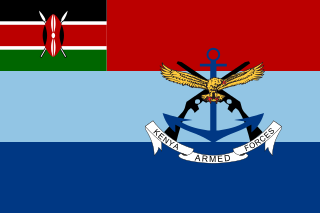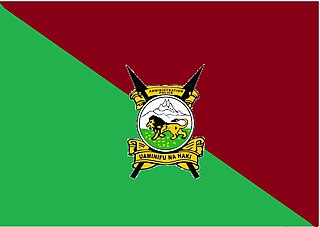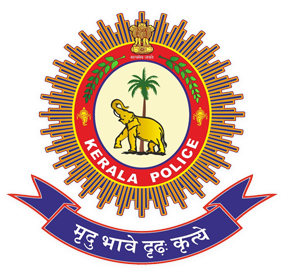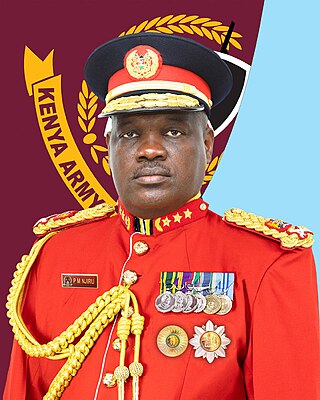
The Kenya Defence Forces (KDF) are the armed forces of the Republic of Kenya. They are made up of the Kenya Army, Kenya Navy, and Kenya Air Force. The current KDF was established, and its composition stipulated, in Article 241 of the 2010 Constitution of Kenya; it is governed by the KDF Act of 2012. Its main mission is the defence and protection of the sovereignty and territorial integrity of Kenya, recruitment to the KDF is done on yearly basis. The President of Kenya is the commander-in-chief of the KDF, and the Chief of Defence Forces is the highest-ranking military officer, and the principal military adviser to the President of Kenya.
Brigadier is a military rank, the seniority of which depends on the country. In some countries, it is a senior rank above colonel, equivalent to a brigadier general or commodore, typically commanding a brigade of several thousand soldiers. In other countries, it is a non-commissioned rank.
Sergeant (Sgt) is a rank in use by the armed forces of many countries. It is also a police rank in some police services. The alternative spelling, serjeant, is used in The Rifles and other units that draw their heritage from the British light infantry. Its origin is the Latin serviens, 'one who serves', through the Old French term serjant.
Commandant is a title often given to the officer in charge of a military training establishment or academy. This usage is common in English-speaking nations. In some countries it may be a military or police rank. It is also often used to refer to the commander of a military prison or prison camp.
The 1982 Kenyan coup d'état attempt was a failed attempt to overthrow President Daniel arap Moi's government. At 3 A.M. on Sunday, 1 August 1982, a group of soldiers from the Kenya Air Force took over Eastleigh Air Base just outside Nairobi, and by 4 A.M. the nearby Embakasi air base had also fallen. At 6 A.M. Senior Private Hezekiah Ochuka and Sergeant Pancras Oteyo Okumu captured the Voice of Kenya radio station in central Nairobi, from where they then broadcast in English and Swahili that the military had overthrown the government. Working at the behest of Ochuka, Corporal Bramwel Injeni Njereman was leading a plot to bomb the State House and the General Service Unit headquarters from the Laikipia Air Base, Nanyuki. Corporal Njereman forced three pilots to fly two F-5E Tiger jets and a Strikemaster that would be used for the mission. However, Major Mutua was aware that Corporal Njereman had never flown a jet fighter before and would likely not be able to cope with the g-forces. The pilots, while communicating on a secret channel, agreed to execute daring manoeuvres to disorient their captor. The trick worked. The pilots dumped the bombs in Mt. Kenya forest and headed back to Nanyuki.
Superintendent (Supt) is a rank in the British police and in most English-speaking Commonwealth nations. In many Commonwealth countries, the full version is superintendent of police (SP). The rank is also used in most British Overseas Territories and in many former British colonies. In some countries, such as Italy, the rank of superintendent is a lower rank.

The Administration Police Service (APS) is a paramilitary security organization and is a branch of the Republic of Kenya's National Police Service.

The General Service Unit (GSU) is a paramilitary wing in the Kenya Police Service, consisting of highly trained police officers, transported by seven dedicated Cessnas and three Bell helicopters. Having been in existence since 1948, the GSU has fought in a number of conflicts in and around Kenya, including the 1963 – 1969 Shifta War and the 1982 Kenyan coup.

Kenya's National Police Service (NPS) is the umbrella law enforcement organ in Kenya. The service was established in 2011 under Article 243 of the Constitution of Kenya, following dissolution of Kenya Police Force and Administration Police Force.

The Kenya Army is the land arm of the Kenya Defence Forces.
The Fake PPO Probe is an investigation ordered by Kenyan President Mwai Kibaki into claims that an individual, Mr Joshua Waiganjo, had for 10 years passed off as a top policeman. He is alleged to have sacked and abused junior officers, and attended top security meetings.
David Mwole Kimaiyo is a Kenyan police officer. He was the first Inspector General of the Kenya Police, a position created by the 2010 Kenyan Constitution to replace the position of Police commissioner. He was the first Kenya head of police whose appointment required approval by parliament.
The New Year Honours 1954 were appointments in many of the Commonwealth realms of Queen Elizabeth II to various orders and honours to reward and highlight good works by citizens of those countries. They were announced on 1 January 1954 to celebrate the year passed and mark the beginning of 1954.
The New Year Honours 1955 were appointments in many of the Commonwealth realms of Queen Elizabeth II to various orders and honours to reward and highlight good works by citizens of those countries. They were announced on 1 January 1955 to celebrate the year passed and mark the beginning of 1955.
The New Year Honours 1957 were appointments in many of the Commonwealth realms of Queen Elizabeth II to various orders and honours to reward and highlight good works by citizens of those countries. They were announced in supplements to the London Gazette of 28 December 1956 to celebrate the year passed and mark the beginning of 1957.
The New Year Honours 1965 were appointments in many of the Commonwealth realms of Queen Elizabeth II to various orders and honours to reward and highlight good works by citizens of those countries. They were announced in supplements to the London Gazette of 29 December 1964 to celebrate the year passed and mark the beginning of 1965.
The Queen's Birthday Honours 1952 were appointments in many of the Commonwealth realms of Queen Elizabeth II to various orders and honours to reward and highlight good works by citizens of those countries. The appointments were made to celebrate the official birthday of The Queen, and were published in supplements of the London Gazette on 30 May 1952 for the United Kingdom and Colonies, Australia, New Zealand, Ceylon, and Pakistan.

The Kerala Police is the law enforcement agency for the Indian state of Kerala. Kerala Police has its headquarters in Thiruvananthapuram, the state capital. The motto of the force is "Mridhu Bhave Dhrida Kruthye" which means "Soft in Temperament, Firm in Action" in Sanskrit. It operates under the Department of Home Affairs, Government of Kerala. The force is headed by the State Police Chief, and the incumbent chief is Shaikh Darvesh Sahib, IPS.

Lieutenant General Peter Mbogo Njiru, is a Kenyan military officer, who serves as the Commander, Kenya Army, since July 2022. The Kenya Army is a service branch of the Kenya Defence Forces (KDF). Before his present assignment, General Njiru was the commander of the Kenya Joint Command and Staff College, at the rank of Major General.












